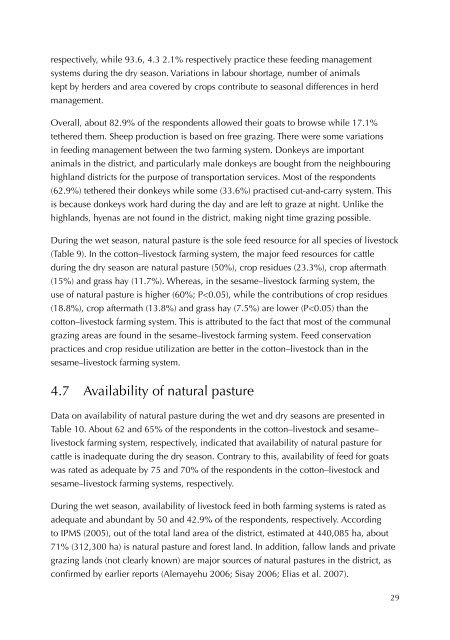Rangeland condition and feed resources in Metema District, North ...
Rangeland condition and feed resources in Metema District, North ...
Rangeland condition and feed resources in Metema District, North ...
Create successful ePaper yourself
Turn your PDF publications into a flip-book with our unique Google optimized e-Paper software.
espectively, while 93.6, 4.3 2.1% respectively practice these <strong>feed</strong><strong>in</strong>g management<br />
systems dur<strong>in</strong>g the dry season. Variations <strong>in</strong> labour shortage, number of animals<br />
kept by herders <strong>and</strong> area covered by crops contribute to seasonal differences <strong>in</strong> herd<br />
management.<br />
Overall, about 82.9% of the respondents allowed their goats to browse while 17.1%<br />
tethered them. Sheep production is based on free graz<strong>in</strong>g. There were some variations<br />
<strong>in</strong> <strong>feed</strong><strong>in</strong>g management between the two farm<strong>in</strong>g system. Donkeys are important<br />
animals <strong>in</strong> the district, <strong>and</strong> particularly male donkeys are bought from the neighbour<strong>in</strong>g<br />
highl<strong>and</strong> districts for the purpose of transportation services. Most of the respondents<br />
(62.9%) tethered their donkeys while some (33.6%) practised cut-<strong>and</strong>-carry system. This<br />
is because donkeys work hard dur<strong>in</strong>g the day <strong>and</strong> are left to graze at night. Unlike the<br />
highl<strong>and</strong>s, hyenas are not found <strong>in</strong> the district, mak<strong>in</strong>g night time graz<strong>in</strong>g possible.<br />
Dur<strong>in</strong>g the wet season, natural pasture is the sole <strong>feed</strong> resource for all species of livestock<br />
(Table 9). In the cotton–livestock farm<strong>in</strong>g system, the major <strong>feed</strong> <strong>resources</strong> for cattle<br />
dur<strong>in</strong>g the dry season are natural pasture (50%), crop residues (23.3%), crop aftermath<br />
(15%) <strong>and</strong> grass hay (11.7%). Whereas, <strong>in</strong> the sesame–livestock farm<strong>in</strong>g system, the<br />
use of natural pasture is higher (60%; P

















